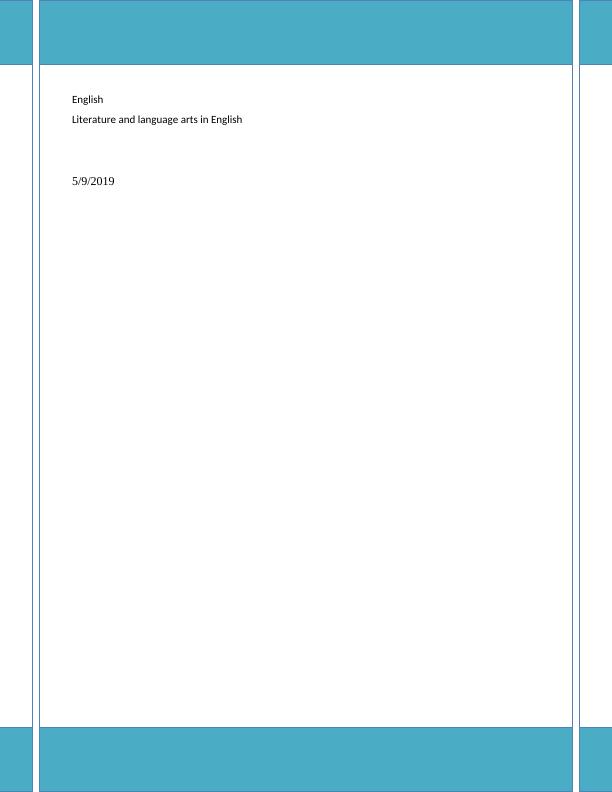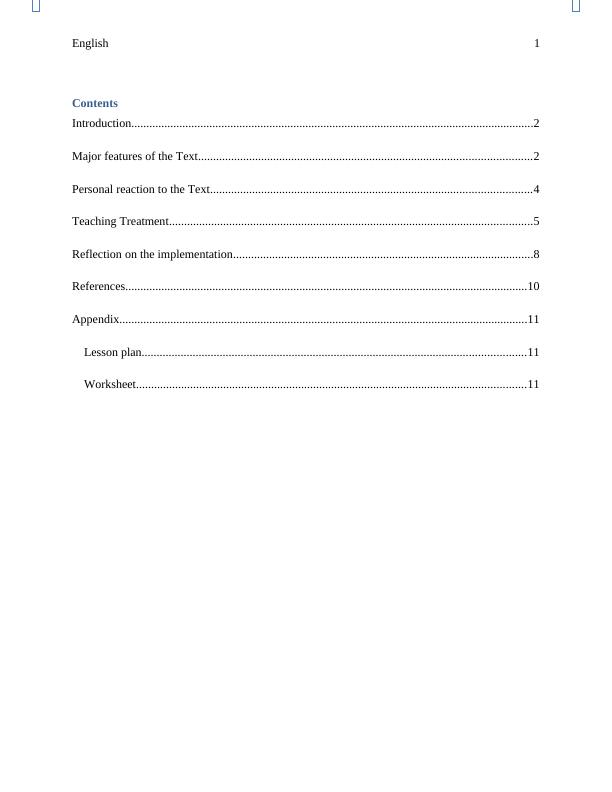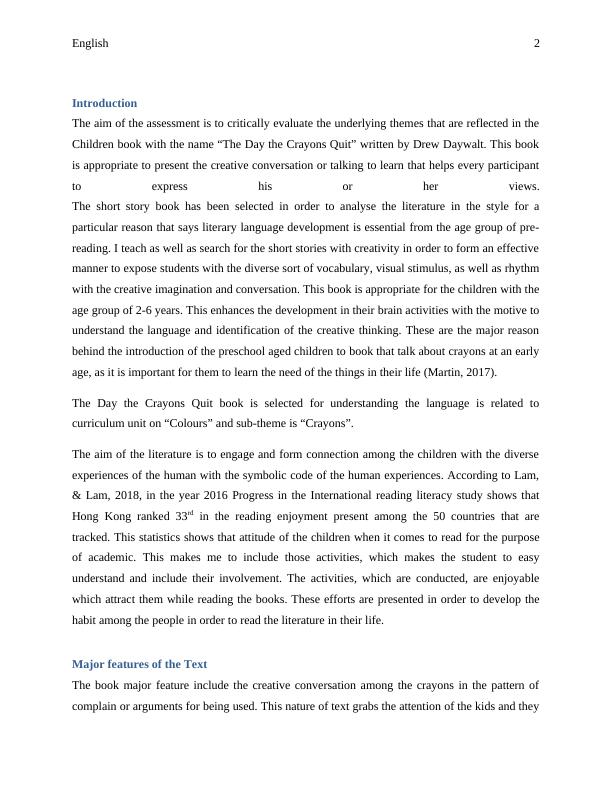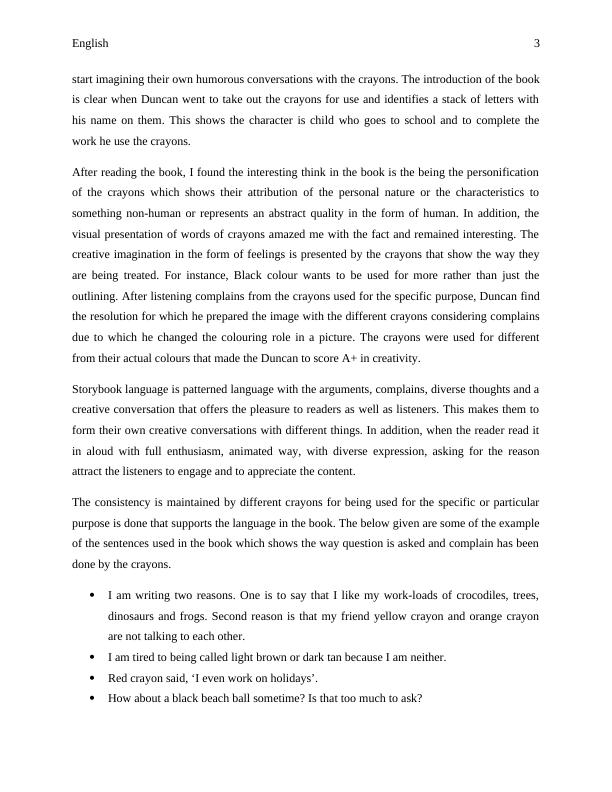The Day the Crayons Quit: A Critical Evaluation
Added on 2023-03-17
13 Pages3717 Words47 Views
English
Literature and language arts in English
5/9/2019
Literature and language arts in English
5/9/2019

English 1
Contents
Introduction......................................................................................................................................2
Major features of the Text...............................................................................................................2
Personal reaction to the Text...........................................................................................................4
Teaching Treatment.........................................................................................................................5
Reflection on the implementation....................................................................................................8
References......................................................................................................................................10
Appendix........................................................................................................................................11
Lesson plan................................................................................................................................11
Worksheet..................................................................................................................................11
Contents
Introduction......................................................................................................................................2
Major features of the Text...............................................................................................................2
Personal reaction to the Text...........................................................................................................4
Teaching Treatment.........................................................................................................................5
Reflection on the implementation....................................................................................................8
References......................................................................................................................................10
Appendix........................................................................................................................................11
Lesson plan................................................................................................................................11
Worksheet..................................................................................................................................11

English 2
Introduction
The aim of the assessment is to critically evaluate the underlying themes that are reflected in the
Children book with the name “The Day the Crayons Quit” written by Drew Daywalt. This book
is appropriate to present the creative conversation or talking to learn that helps every participant
to express his or her views.
The short story book has been selected in order to analyse the literature in the style for a
particular reason that says literary language development is essential from the age group of pre-
reading. I teach as well as search for the short stories with creativity in order to form an effective
manner to expose students with the diverse sort of vocabulary, visual stimulus, as well as rhythm
with the creative imagination and conversation. This book is appropriate for the children with the
age group of 2-6 years. This enhances the development in their brain activities with the motive to
understand the language and identification of the creative thinking. These are the major reason
behind the introduction of the preschool aged children to book that talk about crayons at an early
age, as it is important for them to learn the need of the things in their life (Martin, 2017).
The Day the Crayons Quit book is selected for understanding the language is related to
curriculum unit on “Colours” and sub-theme is “Crayons”.
The aim of the literature is to engage and form connection among the children with the diverse
experiences of the human with the symbolic code of the human experiences. According to Lam,
& Lam, 2018, in the year 2016 Progress in the International reading literacy study shows that
Hong Kong ranked 33rd in the reading enjoyment present among the 50 countries that are
tracked. This statistics shows that attitude of the children when it comes to read for the purpose
of academic. This makes me to include those activities, which makes the student to easy
understand and include their involvement. The activities, which are conducted, are enjoyable
which attract them while reading the books. These efforts are presented in order to develop the
habit among the people in order to read the literature in their life.
Major features of the Text
The book major feature include the creative conversation among the crayons in the pattern of
complain or arguments for being used. This nature of text grabs the attention of the kids and they
Introduction
The aim of the assessment is to critically evaluate the underlying themes that are reflected in the
Children book with the name “The Day the Crayons Quit” written by Drew Daywalt. This book
is appropriate to present the creative conversation or talking to learn that helps every participant
to express his or her views.
The short story book has been selected in order to analyse the literature in the style for a
particular reason that says literary language development is essential from the age group of pre-
reading. I teach as well as search for the short stories with creativity in order to form an effective
manner to expose students with the diverse sort of vocabulary, visual stimulus, as well as rhythm
with the creative imagination and conversation. This book is appropriate for the children with the
age group of 2-6 years. This enhances the development in their brain activities with the motive to
understand the language and identification of the creative thinking. These are the major reason
behind the introduction of the preschool aged children to book that talk about crayons at an early
age, as it is important for them to learn the need of the things in their life (Martin, 2017).
The Day the Crayons Quit book is selected for understanding the language is related to
curriculum unit on “Colours” and sub-theme is “Crayons”.
The aim of the literature is to engage and form connection among the children with the diverse
experiences of the human with the symbolic code of the human experiences. According to Lam,
& Lam, 2018, in the year 2016 Progress in the International reading literacy study shows that
Hong Kong ranked 33rd in the reading enjoyment present among the 50 countries that are
tracked. This statistics shows that attitude of the children when it comes to read for the purpose
of academic. This makes me to include those activities, which makes the student to easy
understand and include their involvement. The activities, which are conducted, are enjoyable
which attract them while reading the books. These efforts are presented in order to develop the
habit among the people in order to read the literature in their life.
Major features of the Text
The book major feature include the creative conversation among the crayons in the pattern of
complain or arguments for being used. This nature of text grabs the attention of the kids and they

English 3
start imagining their own humorous conversations with the crayons. The introduction of the book
is clear when Duncan went to take out the crayons for use and identifies a stack of letters with
his name on them. This shows the character is child who goes to school and to complete the
work he use the crayons.
After reading the book, I found the interesting think in the book is the being the personification
of the crayons which shows their attribution of the personal nature or the characteristics to
something non-human or represents an abstract quality in the form of human. In addition, the
visual presentation of words of crayons amazed me with the fact and remained interesting. The
creative imagination in the form of feelings is presented by the crayons that show the way they
are being treated. For instance, Black colour wants to be used for more rather than just the
outlining. After listening complains from the crayons used for the specific purpose, Duncan find
the resolution for which he prepared the image with the different crayons considering complains
due to which he changed the colouring role in a picture. The crayons were used for different
from their actual colours that made the Duncan to score A+ in creativity.
Storybook language is patterned language with the arguments, complains, diverse thoughts and a
creative conversation that offers the pleasure to readers as well as listeners. This makes them to
form their own creative conversations with different things. In addition, when the reader read it
in aloud with full enthusiasm, animated way, with diverse expression, asking for the reason
attract the listeners to engage and to appreciate the content.
The consistency is maintained by different crayons for being used for the specific or particular
purpose is done that supports the language in the book. The below given are some of the example
of the sentences used in the book which shows the way question is asked and complain has been
done by the crayons.
I am writing two reasons. One is to say that I like my work-loads of crocodiles, trees,
dinosaurs and frogs. Second reason is that my friend yellow crayon and orange crayon
are not talking to each other.
I am tired to being called light brown or dark tan because I am neither.
Red crayon said, ‘I even work on holidays’.
How about a black beach ball sometime? Is that too much to ask?
start imagining their own humorous conversations with the crayons. The introduction of the book
is clear when Duncan went to take out the crayons for use and identifies a stack of letters with
his name on them. This shows the character is child who goes to school and to complete the
work he use the crayons.
After reading the book, I found the interesting think in the book is the being the personification
of the crayons which shows their attribution of the personal nature or the characteristics to
something non-human or represents an abstract quality in the form of human. In addition, the
visual presentation of words of crayons amazed me with the fact and remained interesting. The
creative imagination in the form of feelings is presented by the crayons that show the way they
are being treated. For instance, Black colour wants to be used for more rather than just the
outlining. After listening complains from the crayons used for the specific purpose, Duncan find
the resolution for which he prepared the image with the different crayons considering complains
due to which he changed the colouring role in a picture. The crayons were used for different
from their actual colours that made the Duncan to score A+ in creativity.
Storybook language is patterned language with the arguments, complains, diverse thoughts and a
creative conversation that offers the pleasure to readers as well as listeners. This makes them to
form their own creative conversations with different things. In addition, when the reader read it
in aloud with full enthusiasm, animated way, with diverse expression, asking for the reason
attract the listeners to engage and to appreciate the content.
The consistency is maintained by different crayons for being used for the specific or particular
purpose is done that supports the language in the book. The below given are some of the example
of the sentences used in the book which shows the way question is asked and complain has been
done by the crayons.
I am writing two reasons. One is to say that I like my work-loads of crocodiles, trees,
dinosaurs and frogs. Second reason is that my friend yellow crayon and orange crayon
are not talking to each other.
I am tired to being called light brown or dark tan because I am neither.
Red crayon said, ‘I even work on holidays’.
How about a black beach ball sometime? Is that too much to ask?

End of preview
Want to access all the pages? Upload your documents or become a member.
Related Documents
Teaching Ideas for Language Learning in Early Childhood Settinglg...
|12
|1859
|486
Developing Early Literacy: Assessment and Teachinglg...
|9
|1857
|394
Enhancing Literacy and Language Development in Preschool Childrenlg...
|9
|2550
|239
Reading Plan Assignmentlg...
|3
|408
|49
English Teaching and Learning Curriculum Unitlg...
|11
|2825
|349
The Functional Model in Language Analysis - PDFlg...
|21
|1814
|148